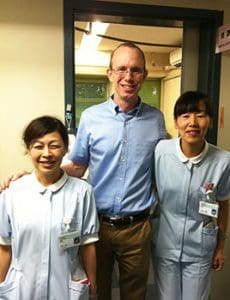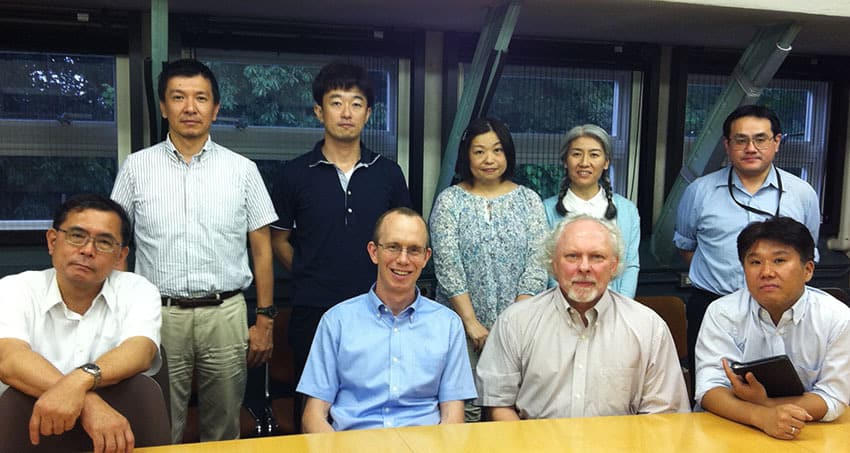Landes Studies Radiation Effects in Hiroshima
| Sept. 18, 2015 | What started as a personal connection to Japan and Japanese culture when he was a small child has grown into a big development in the professional and family life of Reid D. Landes, Ph. D.

Landes, center, visits at the foundation with two of his coworkers, Keiko Hanaoka, left, and Kiyomi Touhouda.
He recently completed a two-year stint as a biostatistician at the Radiation Effects Research Foundation (RERF) in Hiroshima.
“My best friend in kindergarten and first grade was Japanese, so he put Japan on my map,” Landes said. “Then in college, I had some Japanese friends. In 1996, I got to teach English in Japan for a year, and chose Fukushima because it was near my college friends.”
It was while walking on the banks of the Amano River in Fukushima that he made a decision to give up teaching math and English, and pursue a career in statistics. Although nothing along the walk triggered the choice, the moment remained in his memory, and he has stayed on that career path ever since.
Today, Landes is an associate professor in the Department of Biostatistics, which is in the UAMS Fay W. Boozman College of Public Health and the UAMS College of Medicine.
His time in Fukushima, Japan was long before the nuclear disaster caused by the 2011 earthquake and tsunami – all of which devastated the area where he lived, and more than 50 years after the nuclear bombing of Hiroshima in 1945.
Starting in 2013, Landes returned to Japan to live and do research at RERF in Hiroshima. He said that while taking that walk in Fukushima, he never planned for his career in statistics to be a way back to Japan, but eventually it became just that.
He has collaborated in the past with radiation health researchers in the College of Pharmacy’s Division of Radiation Health, and his RERF experience will allow him to contribute further to the talent pool of radiation health scientists at UAMS.
His return to Japan was motivated by his desire to learn more about radiation effects and to put his own statistical expertise to use at RERF. One of 250 staff there, he held a joint appointment with the foundation and the U.S. National Academy of Sciences.
As part of a U.S.-Japan agreement, the foundation was established in 1975 to continue studies started in 1948 of Hiroshima and Nagasaki atomic-bomb survivors and their children. The studies are some of the longest-running epidemiological studies in history. About 30 percent of the study participants are still living.
“The data sets were larger, more complex and richer than any on which I’ve worked in the past,” Landes said. They included data collected from more than 120,000 people.
In one of his collaborations to be published in the American Journal of Medicine, radiation effects on cognitive abilities as people age were estimated to be “less than what a retiree might expect to lose by having another birthday,” Landes said. “But the participants in that study were already teenagers at the time of the bomb. In the next study we’ll look to A-bomb survivors who were children at the time.”
Previous RERF studies found mutations in thyroid cells of the nuclear bomb survivors who were pregnant in August 1945, but failed to find the same in their babies. Scientists working with Landes are looking for an explanation. Examining thyroid cells of adult mice exposed to radiation as fetuses at different stages of thyroid development may provide some answers.
Landes continues work with an RERF researcher looking at whether radiation is related to atrial fibrillation – a risk factor for stroke and heart failure – 25-65 years after exposure.
Through his work at the foundation in Hiroshima, Landes more clearly realized a social truth about radiation effects: That the effects of radiation on health are complex, although the public and media often misunderstand that complexity and fear all kinds of radiation.
“People are frightened of radiation in part because of the unknowns that still surround it,” Landes said. “They’ve heard it causes leukemia or cancer. It’s scary. Scientists and media do not communicate well about it. They should strive to communicate about it more clearly.”
For the entire two years he lived in Japan, his wife, daughter and two sons lived there with him.
“I’m sure I made plenty of cultural missteps while over there; my family, too, but the folks seemed quick to forgive,” Landes said.
He said he and his family appreciate and miss the politeness of the Japanese and the value they place on keeping order, although that value sometimes can lead to a rigidity of thinking that made it hard to solve problems outside the everyday.
“Japanese food is a substantial part of their culture,” Landes said. “Even if you don’t like it, just seeing the breadth and depth of their food culture is amazing. But, my family definitely has American-made tongues. I’ll eat pretty much anything, so I often got seconds, thirds and sometimes more helpings of those wonderful Japanese dishes.”
While in Japan, he said he also gained a new appreciation for American appliances, especially washers and dryers. The Japanese equivalents are slower and less efficient. Landes expressed relief at being able on his return to Arkansas to be able to do several loads of laundry in an afternoon.
Despite occasional everyday difficulties like those, he said overall the shared experience his family had in Japan over the two years allowed them to expand their awareness of another culture and people and grow as individuals. His professional experience as RERF was equally enriching.
“I’d love to continue to work with that group over there,” Landes said. “I have some things in place that I think will continue for a while.”
